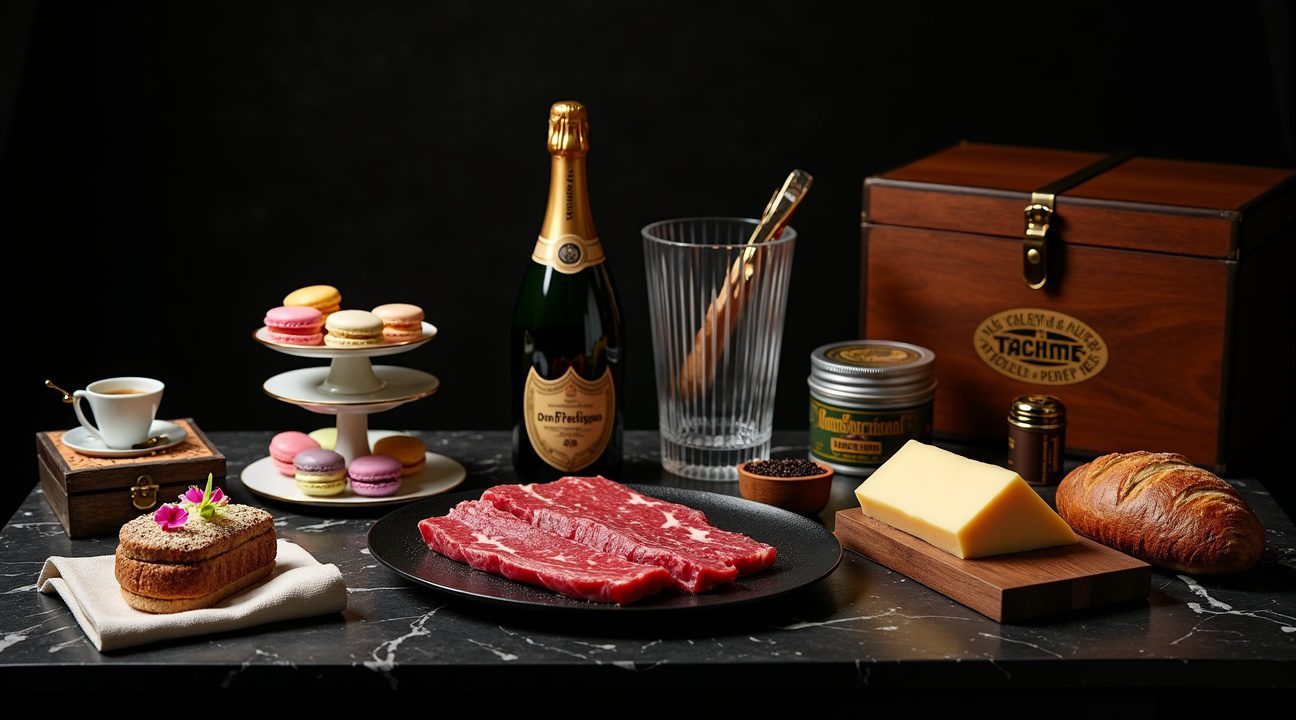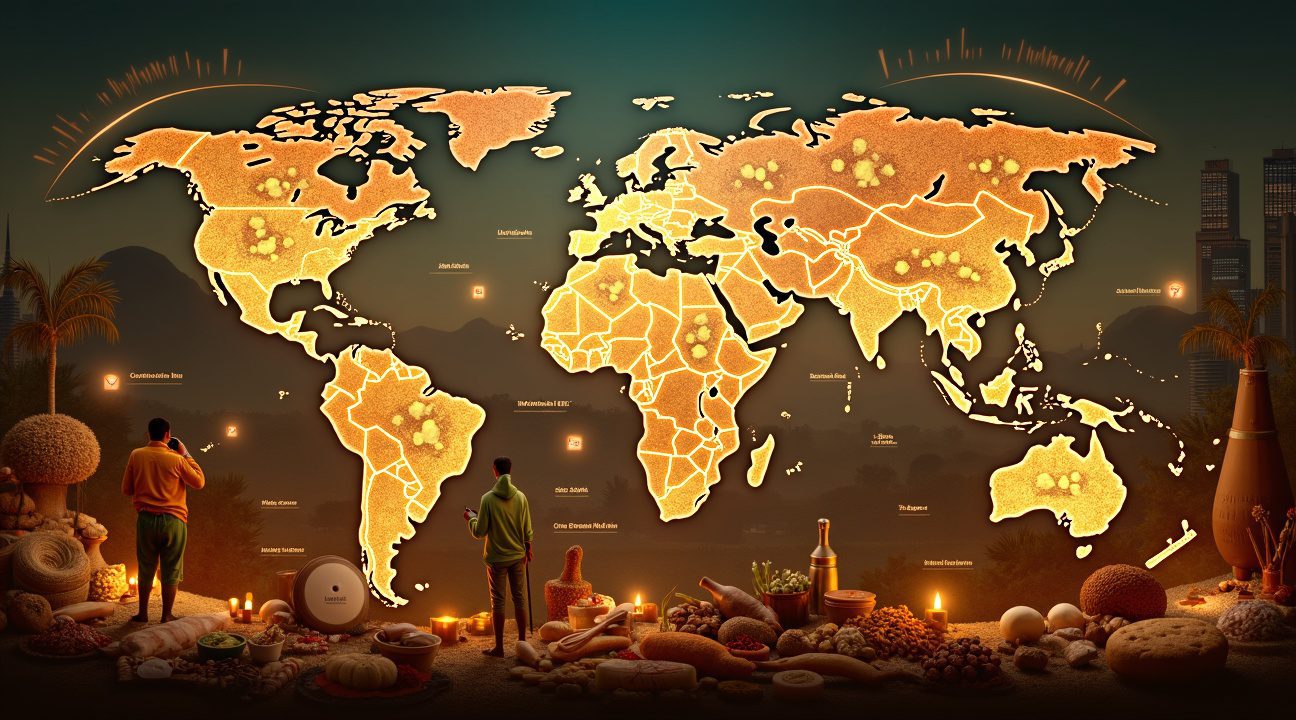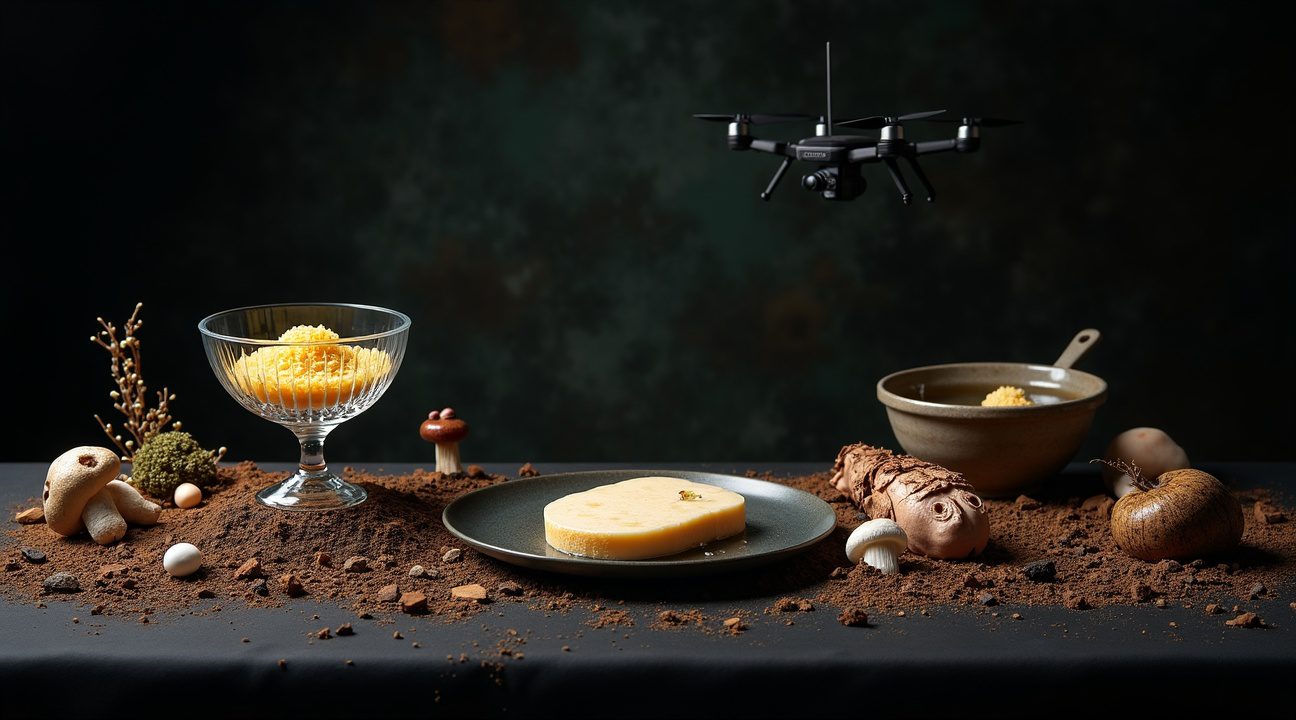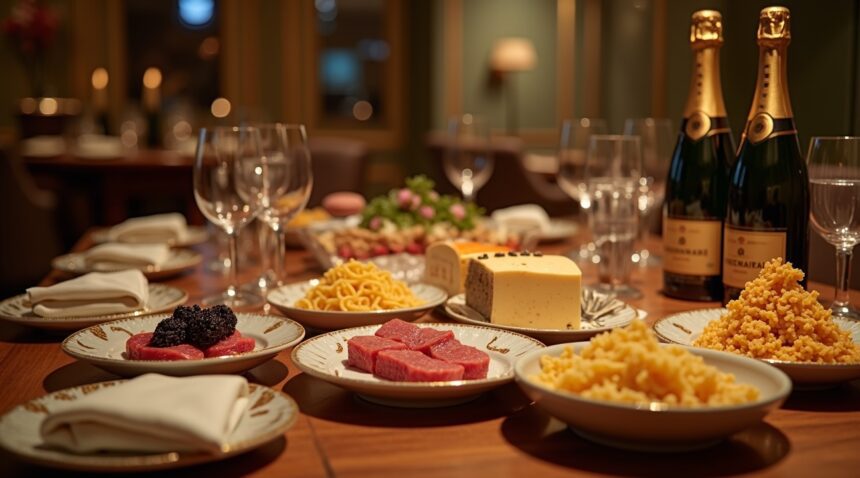The luxury food industry operates on principles far removed from conventional food markets, where astronomical prices reflect intricate combinations of scarcity, traditional production methods, and sophisticated marketing strategies that create near-$900 billion in annual revenue.
Behind the glamorous facade of premium dining experiences lies a complex web of governmental protections, technological innovations, and ethical challenges that fundamentally reshape how consumers perceive and purchase food.
Key Takeaways
- Explosive market growth: The luxury food market projects expansion to $550–898 billion by 2030–2034, driven by rising disposable incomes, urbanization, and the expansion of middle-class consumers, especially in Asia-Pacific regions.
- Premium pricing factors: Prices reflect genuine scarcity such as 20-year sturgeon maturation, traditional artisanal methods maintained through generations, and advanced authentication technologies to combat counterfeiting.
- Government certification and protection: National programs like France’s Label Rouge and Geographical Indications transform regional specialties into high-value global luxury goods while safeguarding cultural food heritage.
- Digital influence and wellness trends: Social media has redefined luxury dining aesthetics, while demand for health-conscious choices led to a 10.5% rise in organic luxury food products.
- Sustainability concerns and innovation: The sector faces ecological issues such as overfishing sturgeon, unsustainable truffle harvesting, and animal welfare conflicts, sparking interest in lab-grown alternatives and blockchain-based traceability systems.
Why Luxury Foods Are the World’s Fastest Growing Market Worth Nearly $900 Billion
I’ve witnessed an extraordinary transformation in consumer spending habits that’s reshaping the global food industry. The luxury food market stands as one of the most dynamic sectors in modern commerce, with projections showing remarkable expansion from approximately USD 160.51 billion in 2022 to an anticipated USD 550.65 billion to USD 898.0 billion by 2030–2034.
This explosive growth trajectory reflects a compound annual growth rate (CAGR) between 16.5% and 17.45%, dramatically outpacing traditional consumer food categories. Several powerful forces drive this unprecedented expansion, fundamentally altering how people approach premium culinary experiences.
Economic Forces Fueling Premium Food Demand
Rising disposable incomes across developed and emerging markets create the foundation for luxury food consumption patterns I observe today. Urbanization accelerates this trend as city dwellers gain access to sophisticated dining options and gourmet retailers. The expansion of the middle class, particularly in Asia-Pacific regions, generates substantial new customer bases eager to explore high-end culinary offerings.
Food tourism emerges as a significant catalyst in this growth story. Culinary travel contributed an estimated USD 1.4 trillion to global travel expenditures in 2023, with luxury food experiences claiming a substantial portion of these revenues. Travelers increasingly seek authentic, premium dining adventures that justify higher price points for exceptional quality and unique experiences.
Consumer behavior shifts reveal deeper motivations behind luxury food purchases. Modern buyers view premium ingredients and exclusive dining as investments in personal well-being and social status. Culinary exploration becomes a form of cultural education, driving demand for artisanal products and chef-driven concepts.
Digital platforms amplify luxury food visibility through:
- Social media showcasing
- Online marketplace accessibility
- E-commerce channels that democratize access
- Brand curation and exclusivity strategies
Supply chain innovations enable year-round availability of seasonal delicacies and exotic ingredients that command premium prices. Cold chain logistics and expedited shipping allow luxury food producers to reach global markets while preserving product integrity and exclusivity appeal.
The convergence of health consciousness and luxury consumption creates additional market opportunities. Premium organic ingredients, rare superfoods, and artisanal preparations appeal to affluent consumers prioritizing both quality and wellness in their dietary choices.
The Price of Perfection: What Makes Caviar Cost $6,000 Per Kilogram
I’ve spent years unraveling the mysteries behind luxury food pricing, and the answer isn’t as simple as most people think. The astronomical cost of premium caviar, which regularly exceeds $6,000 per kilogram for Beluga varieties, stems from a perfect storm of scarcity, tradition, and an almost obsessive pursuit of authenticity.
Scarcity Drives Demand to Extraordinary Heights
Rarity forms the foundation of luxury food pricing. White truffles from Alba command up to $4,000 per pound precisely because they can’t be cultivated commercially and grow only in specific soil conditions. Mother Nature controls the supply, creating an unpredictable market where a poor harvest season can double prices overnight.
The same principle applies to the world’s most expensive caviar. Beluga sturgeon take up to 20 years to mature before producing eggs, and overfishing has decimated wild populations. This creates a supply bottleneck that luxury food enthusiasts are willing to pay handsomely to overcome. I’ve observed how collectors treat these ingredients like precious metals, storing them carefully and consuming them sparingly.
Centuries-Old Techniques Guard Sacred Family Secrets
Authenticity carries tremendous weight in luxury food markets. Artisanal production methods passed down through generations create products that simply can’t be replicated through modern mass production. Aged Parmigiano-Reggiano wheels rest in carefully controlled environments for 24 months or longer, developing flavor profiles that result from specific bacterial cultures and aging techniques closely guarded by Italian families for centuries.
Hand-harvested fleur de sel offers another prime example of how traditional methods justify premium pricing. Salt workers in Guérande, France, skim the delicate crystals from salt pond surfaces using wooden tools, just as their ancestors did hundreds of years ago. This labor-intensive process produces only small quantities, making each batch highly coveted among culinary professionals and serious home cooks.
Provenance and traceability have become non-negotiable elements for discerning consumers. They demand transparency about where their luxury ingredients originate, who produces them, and exactly how they’re prepared. Culinary experts increasingly emphasize the importance of understanding ingredient origins when working with premium products.
The darker side of this luxury market involves sophisticated food fraud and counterfeiting schemes. Counterfeit caviar floods the market, with inferior fish eggs artificially colored and packaged to mimic expensive varieties. I’ve seen fake truffles made from inferior mushrooms treated with synthetic truffle oil to fool unsuspecting buyers. These fraudulent products not only cheat consumers but also undermine trust in legitimate producers who invest heavily in authentic production methods.
Companies have responded by investing heavily in food authentication technologies:
- DNA testing to verify caviar species
- Chemical analysis to confirm truffle authenticity
- Blockchain technology for tracking luxury ingredients from source to plate
These systems create unbreakable chains of custody that protect both producers and consumers.
Harvest methods significantly impact final pricing. Wild-caught ingredients command higher prices than farm-raised alternatives, but sustainable farming practices are closing this gap. Some caviar farms now produce eggs that rival wild varieties in quality while maintaining consistent supply chains. These operations combine traditional knowledge with modern aquaculture techniques, creating products that satisfy both quality standards and environmental concerns.
The psychology behind luxury food purchasing reveals fascinating consumer behavior patterns. Buyers don’t just purchase ingredients; they invest in experiences, stories, and exclusivity.
Why consumers pay more for premium culinary experiences:
- Emotional value — such as a $200 portion of truffle shavings — outweighs raw ingredient cost
- Unique stories behind ingredients increase perceived value
- Prestige and exclusivity drive willingness to pay
This emotional component allows producers to maintain premium pricing even when similar products exist at lower price points.
Market dynamics continue evolving as new luxury ingredients emerge and traditional ones become more accessible. Innovative cooking techniques sometimes elevate humble ingredients to luxury status, while climate change threatens traditional production regions for established luxury foods.
Understanding these pricing mechanisms helps consumers make informed decisions about luxury food purchases. Whether investing in authentic caviar or exploring emerging luxury ingredients, knowledge about production methods, authenticity markers, and market dynamics ensures better value for money spent on these extraordinary culinary experiences.
From Wagyu to Dom Pérignon: The Elite Products and Players Defining Luxury
I’ve discovered that the luxury food industry operates on principles that go far beyond simple taste preferences. Premium ingredients like truffles, caviar, and Wagyu beef command astronomical prices not just because they taste exceptional, but because they represent scarcity, tradition, and verified authenticity.
The Icons of Culinary Excellence
The most prestigious food products share common characteristics that elevate them above everyday alternatives. Wagyu beef, for instance, commands prices of several hundred dollars per pound because the cattle receive specific breeding, feeding, and handling techniques passed down through generations. Similarly, Dom Pérignon champagne achieves its status through careful vineyard selection, vintage requirements, and aging processes that can span decades.
I’ve found that certain brands have become synonymous with luxury itself. Ladurée transforms simple macarons into works of art, while Petrossian has built its reputation on sourcing the finest caviar from specific regions. These companies understand that luxury consumers aren’t just purchasing food—they’re buying heritage, craftsmanship, and exclusivity.
Premium cheeses like Parmigiano-Reggiano and Roquefort exemplify how traditional production methods create value. These products require specific aging environments, particular milk sources, and artisanal techniques that machines simply cannot replicate. Fauchon and Fortnum & Mason have mastered the art of curating these exceptional products, presenting them in ways that justify their premium positioning.
Certification and Authenticity
Government-backed certifications play a crucial role in maintaining luxury food standards. France’s Label Rouge certification ensures that products meet stringent quality requirements beyond standard regulations. The Indication Géographique Protégée (IGP) system protects regional specialties, guaranteeing that authentic products come from their traditional origins.
I’ve observed how cooking methods and production techniques significantly impact a product’s luxury status. Valrhona chocolate achieves its premium position through careful bean selection and processing methods that preserve subtle flavor notes. Pierre Hermé revolutionizes traditional pastry-making by incorporating unexpected flavor combinations while maintaining classical techniques.
The seafood segment demonstrates how geography and harvesting methods determine luxury status. Specialty items from specific waters command higher prices because environmental conditions affect taste profiles. Beluga Group and similar companies invest heavily in sourcing relationships that ensure consistent quality and authentic provenance.
Restaurants like Per Se have elevated luxury dining by showcasing these premium ingredients through innovative preparations. These establishments don’t just serve expensive foods—they create experiences that justify extraordinary pricing through presentation, service, and culinary innovation.
Artisanal bread makers, fine chocolate producers like Godiva and Venchi, and specialty food purveyors understand that luxury customers expect stories behind their purchases. Each product carries narratives about origin, production methods, and the people who create them, transforming simple consumption into cultural experiences.

How Social Media and Wellness Trends Are Reshaping Luxury Dining
I’ve observed how social media platforms have completely transformed the luxury food landscape, creating an entirely new ecosystem where visual appeal drives purchasing decisions. Instagram and TikTok have turned every premium meal into a potential viral moment, forcing high-end restaurants and gourmet brands to prioritize photogenic presentation alongside traditional culinary excellence. This shift has created unprecedented demand for rare culinary experiences that offer both exceptional taste and shareability.
Consumer preferences have undergone a massive evolution, with health-conscious buyers now dominating the luxury food space. The U.S. market for organic, natural, and sustainably sourced luxury products experienced remarkable year-over-year growth of 10.5% in 2023, proving that wellness considerations aren’t just trends but fundamental shifts in purchasing behavior. This transformation has pushed luxury food producers to completely reimagine their offerings, prioritizing transparency in sourcing and emphasizing nutritional benefits without compromising the premium experience.
E-commerce platforms have democratized access to exclusive gourmet products in ways that traditional retail never could. Online luxury food retailers now provide detailed product stories, chef recommendations, and curated collections that allow consumers to discover artisanal products from around the globe. This digital accessibility has expanded the customer base far beyond traditional demographics, enabling food enthusiasts from diverse backgrounds to explore premium ingredients and rare delicacies.
The Rise of At-Home Fine Dining
Home entertaining has evolved into a sophisticated art form, with consumers investing heavily in gourmet items that rival restaurant-quality experiences. This trend reflects a fundamental shift in how people perceive luxury dining – it’s no longer confined to exclusive restaurants but has expanded into personal spaces where hosts can create memorable culinary moments. Premium ingredients, artisanal tools, and restaurant-grade equipment have become accessible to home cooks who want to elevate their entertaining game.
Advanced preservation and packaging technologies have revolutionized how luxury foods reach consumers, extending shelf life without compromising quality or flavor profiles. These innovations enable gourmet products to travel greater distances and maintain their premium characteristics, opening new markets that were previously unreachable. Vacuum-sealing techniques, modified atmosphere packaging, and temperature-controlled delivery systems ensure that delicate items like aged cheeses, exotic fruits, and artisanal chocolates arrive in perfect condition.
Flavor enhancement technologies have also played a crucial role in this transformation, allowing producers to intensify natural tastes while maintaining clean labels that health-conscious consumers demand. These developments have created opportunities for luxury food brands to expand their geographical reach while preserving the authentic experiences that justify premium pricing.
Global Power Players: How Governments Protect and Promote Their Luxury Foods
Strategic Government Initiatives Shape Luxury Food Markets
Governments worldwide recognize that luxury foods represent far more than culinary excellence—they’re powerful economic engines and cultural ambassadors. I’ve observed how strategic policy frameworks transform local specialties into globally coveted products through sophisticated certification programs and regulatory measures.
France’s “Label Rouge” certification stands as perhaps the most influential quality assurance system in luxury food production. This program strictly controls production methods, ensuring that certified products meet exceptionally high standards while preserving traditional techniques. Similarly, India’s “One District One Product” initiative strategically promotes unique regional specialties, transforming local delicacies into national and international luxury brands.
These certification schemes accomplish several objectives simultaneously:
- Preserve traditional production methods and cultural heritage
- Create premium market positioning for regional specialties
- Generate export revenue through enhanced global recognition
- Protect producers from inferior imitations through geographical indication rights
- Build consumer confidence through standardized quality assurance
North America currently dominates the global luxury food market, leveraging strong regulatory frameworks and sophisticated distribution networks. However, the Asia-Pacific region and Middle East are experiencing unprecedented growth in luxury consumption, driven by rising disposable incomes and changing consumer preferences. This shift creates new opportunities for government-backed luxury food initiatives.
Luxury food exports face substantial challenges that governments must address through careful policy design. Tariffs can dramatically impact market access, while import quotas limit distribution potential. International food safety standards require constant adaptation, particularly as cooking methods and preservation techniques evolve.
I’ve noticed that successful government programs share common characteristics: they balance tradition preservation with market innovation, provide clear quality benchmarks, and facilitate international market entry. Countries that invest in comprehensive certification schemes often see their luxury food exports become significant economic contributors.
Geographic indication protection has become increasingly important as global luxury food markets expand. These legal frameworks prevent unauthorized use of regional names and production methods, ensuring that consumers receive authentic products while protecting producers’ investments in quality and tradition.
Government initiatives also address supply chain vulnerabilities that could compromise luxury food quality. By establishing strict monitoring systems and providing technical assistance to producers, these programs maintain the premium positioning that luxury foods require. Strategic partnerships between government agencies and private sector players often accelerate market penetration while maintaining quality standards.
The interplay between regulatory protection and market promotion reveals how governments can effectively nurture luxury food industries while preserving cultural authenticity.

The Dark Side of Luxury: Environmental Impact and Ethical Dilemmas
Behind the glittering facade of luxury dining lies a troubling reality that many consumers never see. I’ve discovered that the high-end food industry harbors significant environmental and ethical challenges that contradict its sophisticated image.
Caviar production represents one of the most striking examples of environmental destruction in luxury foods. Overfishing of sturgeon species has pushed several varieties to the brink of extinction, with wild beluga sturgeon now critically endangered. The pursuit of these prized eggs has devastated river ecosystems across Europe and Asia, forcing producers to rely heavily on aquaculture operations that often lack proper oversight.
Truffle hunting presents another concerning case study. Traditional harvesting methods involve trained dogs or pigs digging up these underground fungi, but aggressive commercial operations have begun using destructive techniques that damage forest floors and disrupt delicate mycorrhizal networks. These practices threaten the long-term sustainability of truffle habitats and the broader forest ecosystems they support.
The production of foie gras continues to generate intense ethical debates due to force-feeding practices. Ducks and geese undergo gavage, a process where workers insert tubes down their throats to rapidly enlarge their livers. Animal welfare advocates have successfully lobbied for bans in several jurisdictions, though the luxury ingredient remains available in many markets.
Bluefin tuna fishing exemplifies how luxury demand can drive species toward extinction. These magnificent fish command astronomical prices at auctions – sometimes exceeding $100,000 for a single specimen – creating powerful economic incentives for overfishing. Despite international quotas and conservation efforts, illegal fishing operations continue to target these slow-reproducing giants.
Industry Response and Reform Efforts
Progressive luxury food companies have begun implementing comprehensive reform measures to address these challenges. Sustainable sourcing initiatives now require suppliers to meet strict environmental standards, while third-party certification programs help verify ethical practices throughout supply chains.
Advanced traceability systems utilize blockchain technology and DNA testing to track products from origin to plate. These innovations help prevent fraud while ensuring that endangered species don’t enter legitimate markets. Restaurants and retailers can now provide customers with detailed provenance information, creating transparency that was previously impossible.
Regulatory bodies have strengthened enforcement mechanisms to combat illegal practices. Enhanced penalties for violations, combined with improved monitoring technologies, have made unethical operations riskier and less profitable. International cooperation between conservation organizations and law enforcement agencies has also intensified efforts to protect vulnerable species.
Alternative production methods offer promising solutions for traditionally problematic luxury foods:
- Cell-cultured foie gras eliminates animal welfare concerns while maintaining the desired taste and texture.
- Aquaculture innovations now enable sustainable caviar production without depleting wild sturgeon populations.
Farm-to-table movements within luxury dining emphasize local sourcing and seasonal ingredients, reducing transportation emissions while supporting regional ecosystems. High-end chefs increasingly partner with sustainable producers who prioritize environmental stewardship over maximum yield.
Consumer awareness campaigns have educated buyers about the environmental and ethical implications of their purchasing decisions. Culinary experts now regularly discuss sustainability issues, helping shift public opinion against environmentally destructive practices.
Investment in research and development has accelerated the creation of luxury alternatives that satisfy discerning palates without compromising ethics. Lab-grown seafood, plant-based caviar substitutes, and synthetic truffle compounds represent just the beginning of this transformation.
The luxury food industry stands at a critical juncture where traditional practices must evolve to meet modern ethical standards. While progress has been made, significant challenges remain in balancing exclusivity with responsibility. Companies that embrace sustainable practices early will likely gain competitive advantages as consumers become increasingly conscious of their environmental impact. The future of luxury dining depends on the industry’s ability to maintain sophistication while respecting planetary boundaries and animal welfare.

Sources:
Market.us – Luxury Food Market Report
Zion Market Research – Luxury Foods Market
Custom Market Insights – Luxury Food Market
Technavio – Luxury Food Market Analysis


